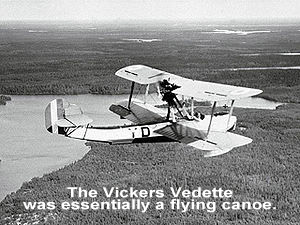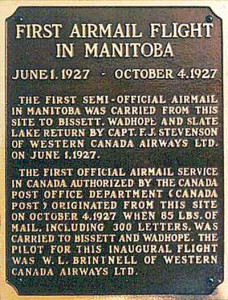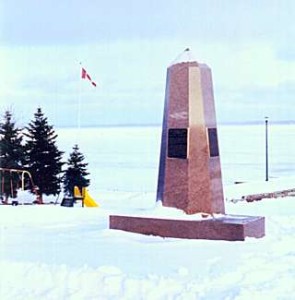Early Aviation History
 The first recorded use of Lac du Bonnet as a base of operations for an aircraft is July of 1922 when the Canadian Air Force (pre RCAF 1924) was doing survey work in the area.
The first recorded use of Lac du Bonnet as a base of operations for an aircraft is July of 1922 when the Canadian Air Force (pre RCAF 1924) was doing survey work in the area.
Western Canada Airways followed in 1926 and the RCAF in 1927. In 1924 Canadian Vickers of Montreal designed and built the Vedette flying boat for the RCAF and they operated a number of these aircraft out of Lac du Bonnet until 1933. Amoung many of its achievements it was the first designed and built aircraft in Canada. Due to the “depression of 1929”, cutbacks in RCAF personnel resulted in layoffs and a reductions in Civil Operations.
In 1932 negotiations between the Dominion Government and the Province of Manitoba resulted in the RCAF turning over six Mk.ll Vedette flying boats for the sum of $ 1.00 each with the provision that the Manitoba Government would also employ five ex RCAF pilots who had been released from active service. Later two newer Mk.V Vedettes were added to the fleet.
 This was the start of the Manitoba Government Air Service and the construction of its main base of Operation and Maintenance in Lac du Bonnet.
This was the start of the Manitoba Government Air Service and the construction of its main base of Operation and Maintenance in Lac du Bonnet.
The last Vedette aircraft, CF-MAG, was withdrawn from service in 1937. (The salvaged remains are on view at the Western Canada Aviation Museum, Winnipeg, MB.) The service history of the Vedette and the pilots and engineers who flew in them is well recorded in the annals of Canadian accomplishments. Residents of Lac du Bonnet worked for and with the air and ground crews and remember this part of their history.
Throughout the 1920’s, 30’s and 40’s many other companies, such as Western Canada Airways (Canadian Airways), Starratt Airways, Wings Limited, Canadian Pacific Airlines, Central Northern Airways, Trans Air Limited, Wendigo Wings, Air Park and Whiteshell Air Service, operated out of Lac du Bonnet.
Today Provincial Helicopters and Adventure Air are the only two companies currently serving the community. As well many private operators made Lac du Bonnet their base of operations.
From our past history one can see that Aviation played a significant roll in the cultural, economic and social life of our community. The Vickers Vedette is a significantly unique aircraft to remind us of our past and will further enhance the cairn already in place that commemorates the existence of RCAF Station Lac du Bonnet.














